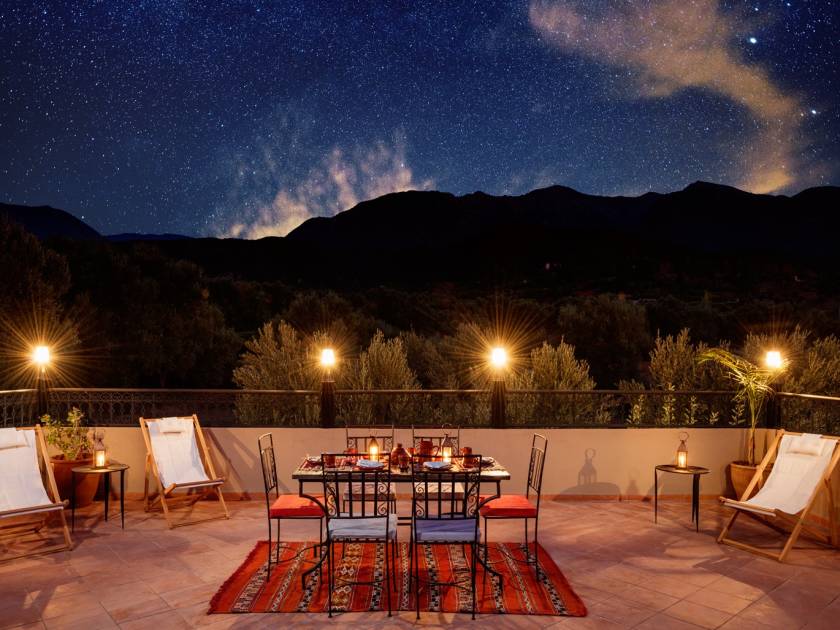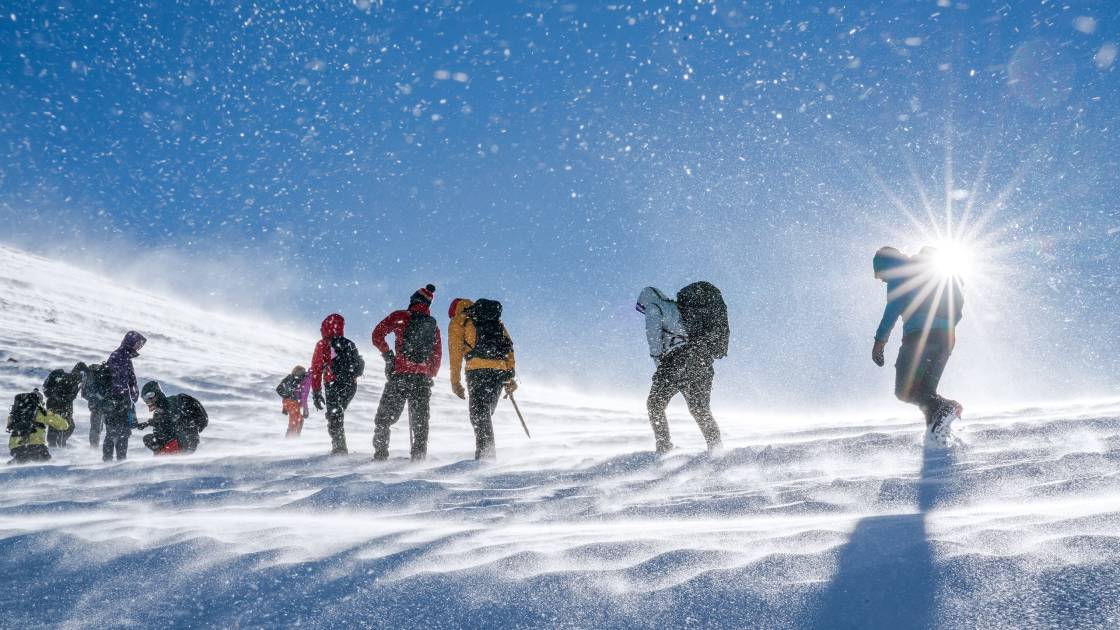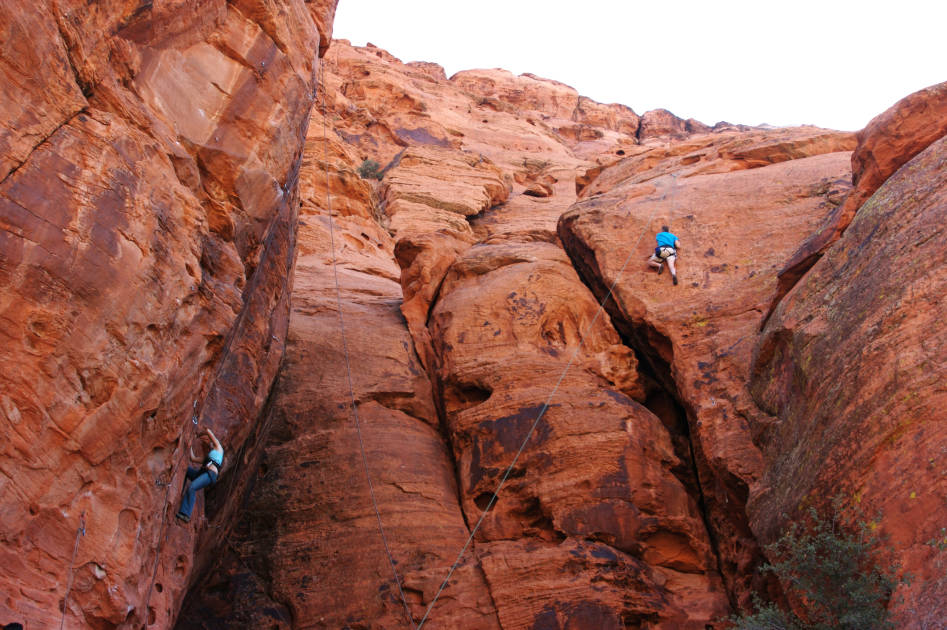

The Atlas Mountains are a series of mountain ranges extending for almost 2,000 kilometres across north Africa, passing through Morocco, Algeria and Tunisia. The jagged, sky-piercing High Atlas in Morocco are perhaps the most well-known, especially in the trekking community. This is where you’ll find snow-capped Mount Toubkal, the highest peak in north Africa, a towering stone giant of 4,167m. And there are plenty of treks in the Atlas Mountains beyond Toubkal, along barely-used trails between remote Berber villages; over wild stony mountain passes beneath a burnt blue sky.
Although the High Atlas might be the most popular part of the Atlas Mountains to visit, there’s plenty of other spots to adventure in. The Anti-Atlas Mountains, close to the port city of Agadir, is a lunar-like landscape of red granite boulders and ancient lava flows. This sparse topography contrasts with its lush green valleys, which is where you’ll find the farms and settlements of the Chleuh people.

The Saharan Atlas in Algeria is sparse and desert-dry, whereas the northern slopes of the Tell Atlas Range are forested with Atlas cedar, pine and cork oak. Visiting either of these two ranges will take you very much off-the-beaten-track.
It will come as no surprise, then, that the Atlas Mountains are astonishingly diverse, both topographically and culturally. There are all sorts of different adventures to be had amongst its peaks. The only problem is choosing where – and when – to go. This guide will help you narrow down your options, and highlight a few of the adventurous activities on offer.
Where are the Atlas Mountains?
 A map of the Atlas Mountains. Map: Wikimedia Commons
A map of the Atlas Mountains. Map: Wikimedia CommonsThe Atlas Mountains run from the Moroccan port of Agadir in the southwest, across the north of Algeria, and to the Tunisian capital of Tunis in the northeast. They rise up to form a high barrier between the Mediterranean basin in the north, and the Sahara Desert in the south.
The most northerly section is the Tell Atlas, extending from northern Morocco and along the northern coast of Algeria. It consists of several massifs, the westernmost of which is the Rif Mountains, which form a crescent shape between Ceuta and Melilla in Morocco. The most southerly range is the Anti-Atlas, in Morocco. Above and parallel to it rise the spectacular High Atlas peaks of Morocco.
How tall are the Atlas Mountains?
 It’s still a long way to the top of Mount Toubkal! Photo: Much Better Adventures.
It’s still a long way to the top of Mount Toubkal! Photo: Much Better Adventures.The Atlas Mountains are renowned for their imposing size, especially at their pinnacle in the High Atlas. Morocco’s seven highest peaks are all located in the High Atlas.
Jebel Toubkal (Jebel means mountain) is the highest peak in the the whole of the Atlas Mountains, never mind Morocco, at 4,167m. Next up is Ouanoukrim Mountain, which consists of two summits, Timzguida (4,089m) and Ras Ouanoukrim (4,083m). Third is M’Goun, (4,071m), a lunar-like mountain ridge which can be reached after a five-day trek.

Outside of the High Atlas, you’ll find plenty of peaks exceeding 3000m in Morocco. This includes Mount Bou Naceur (3,400m), the highest peak of the Middle Atlas, and Mount Sirwa (3,304m), the highest peak of the Anti-Atlas.
While the Atlas in Tunisia and Algeria might not reach the lofty heights of those in Morocco, their summits are still not to be sniffed at. The highest mountain in the Algerian Atlas is Mount Chelia (2,328m), which is in the the Aurès Mountains (the easternmost portion of the Atlas mountain range). In Tunisia, Mount Chambi – also known as Ash-Shaʿnabī – is the tallest mountain in the country at 1,544m. It is located in the Saharan Atlas.
When to visit the Atlas Mountains
 During the spring, the meadows in the Atlas foothills are carpeted with wildflowers. Photo: Getty.
During the spring, the meadows in the Atlas foothills are carpeted with wildflowers. Photo: Getty.Considering the climactic variations and differences in altitude between different ranges in the Atlas, the answer to this question is not a simple one. Broadly speaking, however, the best time to visit the Atlas Mountains is considered to be between March to November. In the spring time you’ll be treated to lush vegetation and a profusion of wildflowers, and cool, refreshing temperatures. There will still be snow on the higher mountains, such as Toubkal, up until May.
Temperatures soar in North Africa during the summer months. Having said that, there’s around a 15°C difference between Morocco’s lowlands and its highlands. While Marrakech sizzles at temperatures exceeding 40°C, you’ll find that the High Atlas temperatures are in the high twenties or low thirties (dropping lower as you climb Toubkal). However, we’d recommend steering clear of treks at lower altitudes during the summer months – you’ll sizzle.

The Anti-Atlas and Saharan Atlas are ideal to visit between the months of October and May. Winters are mild, with warm days and clear skies (15-20°C), although the temperature plummets as night falls. However, we won’t stop you from climbing Mount Toubkal during winter – this snowy scramble is a real bucket list challenge!
When travelling in North Africa, it’s also worth taking Ramadan into account. During this month, when Muslims fast from sunrise to sunset, some cafes, restaurants and shops are closed during the day. This is especially true in more rural areas – you’re unlikely to encounter difficulties in Morocco, which has a more developed trekking infrastructure. Ramadan falls on different dates each year – in 2023 it’ll be between March and April.
What country in the Atlas Mountains is best to visit?
 Morocco combines spectacular summits with warm Berber hospitality. Photo: Getty.
Morocco combines spectacular summits with warm Berber hospitality. Photo: Getty.Tunisia is a popular destination for beach lovers, but is a hidden gem when it comes to adventure sports. The Tell Atlas in North Tunisia are perfect for trekking, with their green foothills and forests, and views of the blue Mediterranean, and you’ll rarely encounter a soul whilst out hiking.
Algeria has the least tourist infrastructure out of the three – and getting a visa is the most difficult – but the British Backpacking Society ranked the country at number one as the world’s best potential adventure travel destination. They cited its proximity to Europe, lack of overtourism, and spectacular desert scenery as reasons for this.
However, in our opinion, Morocco is the best country in the Atlas Mountains to visit. This is for several reasons. For a start, it’s where you’ll find the highest peaks. But we also love the diversity of mountain landscapes you can experience in Morocco, from its fertile valleys to its snowy peaks and deep gorges. There are also so many options for off-the-beaten track adventures – we’ve listed our five favourites below.
The best things to do in the Atlas Mountains
1. Climb Mount Toubkal
 Standing at snow covered top of the peak of Jebel Toubkal in Atlas mountains Morocco | Photo: Getty
Standing at snow covered top of the peak of Jebel Toubkal in Atlas mountains Morocco | Photo: GettyAt a lofty 4,167 m above sea level, climbing Mount Toubkal is no mean feat. Most people attempt the challenge between May and October. Most people trek up to either the Mouflon or Neltner mountain refuge on the first day (both located at around 3,200m) and then aim for the summit in time to watch the sun rise. Another option is to take a longer route through the Azzadene Valley and over the Aguelzim Mountain pass (3560m) before summiting Toubkal.
It’s also possible to climb Toubkal in winter. There will be snow between October and April, although it may linger in small pockets well into the summer – despite scorching Moroccan temperatures. You’ll need to use crampons and ice axes to reach the top – your guide should give you training on how to use them.

Although this isn’t a technical climb, and mountaineering experience isn’t required, you’ll need to be in peak physical condition. Having a guide with you is mandatory, whatever your skill level. Even if you are an experienced hiker, your guide will know the routes and the mountain intimately, and they’ll also be trained to watch out for signs of altitude sickness.
If you are going with a guided group, it is common to hire muleteers to help carry your belongings to the snowline. That’s a real cultural experience in itself. Many local people make their livelihoods from taking groups up the mountains. Local guide Mohamed started his career by leading the mules for hiking groups, as a teenager. Now he runs his own company and is supporting the local mountain community.
2. Take on Morocco’s Three Peaks Challenge
 Enjoying the view on the Morocco Three Peaks circuit. Photo: Getty.
Enjoying the view on the Morocco Three Peaks circuit. Photo: Getty.If climbing Toubkal isn’t adventurous enough, we’d recommend tackling Morocco’s Three Peaks Challenge. Over a 48 hour period you’ll be ascending Morocco’s three highest mountains – Toubkal, and the Mount Ouanoukrim twin summits, Timzguida (4089m) and Ras (4083m).
You can base yourself at the same refuge (Mouflons, 3,207m) for both treks. We’d recommend tackling Mount Ouanoukrim’s peaks on the first day, and Toubkal on the second. Although much of your energy will be devoted to completing the task at hand, don’t forget to take in the spectacular scenery of the Atlas Mountains.

3. Cycle through the Dadès Valley
 Imagine tackling this route on a bike! Photo: Getty.
Imagine tackling this route on a bike! Photo: Getty.Morocco’s Atlas Mountains aren’t just for hikers. Cyclists will relish tackling the winding mountain roads and the high passes. Although there are plenty of different route options, we’d highly recommend a bikepacking tour through the lunar-like Dadès Valley, which lies between the High Atlas Mountains and the Jbel Saghro Mountains.
One of the highest points on the route is the Tizi n’Tazazert pass (2200m). Cruise the switchbacks all the way to the top for panoramic views of the otherwordly topography. Then it’s time to speed downhill to spend the night at the lush Berber oasis town of N’kob. From there, you can extend your route by heading into the undulating dunes of the Sahara Desert.

4. Go rock climbing in Todgha Gorge
 Enjoying the view while rock climbing in Morocco. Photo: Getty.
Enjoying the view while rock climbing in Morocco. Photo: Getty.Todgha Gorge – a limestone river canyon in the eastern part of the High Atlas – is a popular destination with rock climbing enthusiasts. It’s easy to see why; the craggy red rock faces are perfect for climbing.

If you’re a novice climber, a guide is essential. They’ll set you up with the kit, and give you a safety briefing. Although the cliffs tower 400m high and look austere, there are plenty of routes for novices, especially at the entrance to the gorge. Once you feel confident with the techniques and equipment, you’ll be able to progress to more challenging ones.
5. Explore the green foothills of the High Atlas
 The striking contrast between fertile green valleys and red sandstone mountains. Photo: Getty.
The striking contrast between fertile green valleys and red sandstone mountains. Photo: Getty.Trekking in the Atlas Mountains isn’t just about climbing the highest mountain you can find. It’s also about taking in the scenery and learning about the local culture. We recommend hiking through the Ouirgane Valley, which sits in the foothills of the High Atlas. It’s a beautiful area, where craggy red mountains provide a striking contrast with the lush green vegetation lining the rivers.

As you hike, you’ll pass by clay Berber villages perching on the hills. You’ll witness a traditional way of life, seeing crops grown on steep terraces and enjoying Berber hospitality in the mountain lodges along the way. By staying in local lodges, you’ll be helping the livelihoods of these remote communities.